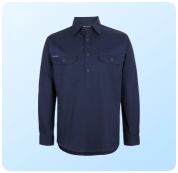
|
Getting your Trinity Audio player ready...
|
The weight of a T-shirt can reveal a great deal about its quality. Most people have likely never considered it. Before making a purchase, knowing a T-shirt’s weight is essential, as it can affect its appearance and comfort.
T-shirts that weigh less are made of thinner material, making them more susceptible to tearing. T-shirts that weigh more are usually made of a denser material, making them more durable.
For instance, using approximately 0.4 pounds of heavyweight cotton in T-shirts makes them highly durable and long-lasting.
Learn More: Polyester vs Cotton vs Blends: Which One Is Better?
What is the Shirt’s Weight?
It is a well-known fact that the actual weight of a shirt will vary marginally depending on its size and material composition. A typical garment weighs approximately 0.5 pounds (240 grams) on average.

There are various methods to measure a shirt’s weight, whether you employ the Imperial or Metric system. The average shirt weighs about 0.5 pounds. A shirt may weigh more or less than this, but it will typically fall within this range.
All the preceding information was merely an estimate, and the weight of your garment can vary depending on various factors. Stylish garments with graphics will frequently weigh at least half a pound. Even if they were simplistic graphics, additional content on the shirt would add weight. Here are some common breathable fabrics:
- Cotton
- Polyester
- Spandex
- Synthetic

How Much Does the Average Shirt Weigh?
Men’s
A men’s garment weighs between 0.3 and 0.4 pounds on average. This is equal to between 140 and 170 grams. The fabric influences the shirt’s weight, with heavier fabrics like denim weighing more than lighter materials such as cotton. Men’s shirts are typically larger than women’s, which can add additional weight.
Women
Women’s shirts are typically lighter than men’s due to their smaller dimensions and use of lighter materials. Typically, they weigh between 0.2 and 0.3 pounds or approximately 110 to 140 grams.
However, this can vary based on the garment’s design and material. Notably, these measurements are approximations based on standard measures for both sexes; actual weights may vary due to variations in fabric types and design details.
Does the weight of the T-shirt matter?
The weight of a T-shirt can give you an idea of its quality and the type of fabric used to create it.
For instance, hollow fibres are used to create synthetic materials like polyester. These fibres weigh less than natural fibres, such as cotton, because they are porous.
As a result of having fewer threads per square inch, shirts that weigh less may be less durable than marginally heavier t-shirts.
Even a lightweight T-shirt must weigh a certain quantity to be durable and last more than one season. If a T-shirt is heavier, it will be more expensive to ship a significant quantity of them; therefore, heavier T-shirts may be priced higher due to their weight alone.
However, this price increase is often justified if you want a T-shirt that can withstand frequent wear and laundering.
Benefits of knowing the shirt’s weight
Knowing the weight of a shirt is essential for numerous purposes. First, it helps you determine how much apparel to bring on a trip. Due to their increased weight, heavier shirts may take up more room in your suitcase and be less pleasant to wear.

In addition, it is helpful to know whether a shirt will fit comfortably on your body. Knowing the weight of the fabric can help you make an informed decision if you’re searching for something lightweight that won’t feel weighty against your skin.
Factors affecting t-shirt weight
The weight of a garment can vary considerably based on its material and design. Cotton, linen, and silk are common materials for lightweight shirts, whereas wool blends and heftier fabrics such as flannel are standard for heavyweight shirts.
Fabric
Cotton and polyester are the two most common materials used to manufacture T-shirts.
Cotton is an organic material derived from vegetation. It is plush, absorbent, and breathable.
Polyester is a petroleum-derived synthetic fibre. It is less porous than cotton and often less expensive to manufacture.
Types of Fabric
Depending on the sort of fabric used to create them, T-shirts come in a variety of weights. Heavyweight, light heavyweight and micro weight are the three most common varieties of T-shirts.
Heavy
Heavyweight t-shirts typically weigh over 6 ounces, are constructed from thicker fabrics, and are worn in frigid climates. Additionally, they are less likely to fade when washed.
Mid-weight
Midweight t-shirts typically weigh about 5 ounces, are made of thinner fabrics, and are worn in milder climates. These T-shirts are ideal for days with average temperatures.
Lightweight
Typically, lightweight T-shirts weigh less than 4.5 ounces, feel gentler, and are worn on warmer days.
Micro weight
Micro weight t-shirts are constructed from the thinnest fabrics and are typically worn as activewear or undershirts.
Size
The shirt’s dimensions also influence the weight of a T-shirt. Typically, a more oversized T-shirt will weigh more than a smaller one.
Suggested Read: Choosing the Perfect T-shirt Size for Your Body Type
Manufacturer
The manufacturer can also affect the weight of a T-shirt. Some manufacturers use heavier fabrics than others, resulting in heavier garments.
Brand Preference
The brand of the shirt is the third factor that influences the weight of the T-shirt. Some brands favour heavier T-shirts, while others favour lighter ones.
Since it varies by brand, let’s look at a few prominent brands’ average weights.
- Cotton from the Loom 4.5 oz. – 6 oz.
- Gildan 4.0 to 6.5 oz.
- American Apparel 4.0 to 6.0 oz.
As you can see, there is a slight variation between brands, so the weight of a t-shirt ranges from approx 4 ounces for their lightest shirts to 6 ounces for their heaviest shirts.
| Weight Classification | Weight Range (ounces) | Weight Range (grams) | Description and Considerations |
| Men’s Shirts | 0.3 – 0.4 | 140 – 170 | Influenced by fabric type, larger size adds weight. |
| Women’s Shirts | 0.2 – 0.3 | 110 – 140 | Smaller dimensions and lighter materials. |
| Fabric Types | |||
| Cotton | Varies | Varies | Organic, plush, absorbent, and breathable. |
| Polyester | Varies | Varies | Synthetic, less porous, often less expensive. |
| Weight Varieties | |||
| Heavyweight | > 6 | > 170 | Thicker fabric, suited for cold climates. |
| Mid-weight | ~ 5 | ~ 140 | Thinner fabric, ideal for mild climates. |
| Lightweight | < 4.5 | < 130 | Thinner, gentler, for warmer days. |
| Micro weight | Varies | Varies | Thinnest fabrics, for activewear or undershirts. |
| Factors Affecting Weight | |||
| Size | Larger shirt = Heavier | Larger shirt = Heavier | Larger shirts weigh more. |
| Manufacturer | Varies | Varies | Different manufacturers use different fabrics. |
| Brand Preference | |||
| Cotton from the Loom | 4.5 – 6 | 130 – 170 | Range of weights from the brand. |
| Gildan | 4.0 – 6.5 | 110 – 185 | Range of weights from the brand. |
| American Apparel | 4.0 – 6.0 | 110 – 170 | Range of weights from the brand. |
| Choosing the Right Weight | |||
| Lightweight | Thinner, cooler, less durable | Thinner, cooler, less durable | Consider climate and comfort. |
| Heavyweight | More durable, suited for cold | More durable, suited for cold | Consider durability and climate. |
Which Is the right weight for You?
In general, lightweight shirts are thinner and cooler to wear but may not be as durable as those made from heavier materials. Heavyweight shirts, on the other hand, are typically more durable and better-suitable for colder climates.
It is ultimately up to you to determine which fabric best suits your requirements and lifestyle. Consider climate, durability, comfort level, cost, etc., when choosing lightweight and heavyweight materials for your wardrobe essentials.
Explore Similar Content:
- Men’s Wardrobe Essentials – from Shirts to Accessories
- Women’s Activewear Wardrobe – Fashion in Australia
Conclusion
In conclusion, we can determine a range for the average weight of t-shirts based on the factors above.
When purchasing a shirt, the best thing to do is to pay attention to its weight, indicating whether it is heavyweight, midweight, or lightweight. One thing to keep in mind is that light fabrics require gentler care when laundering, whereas heavier materials may require more scrubbing force.
More Suggested Reads:
- Why Eco-Friendly T-Shirts Are Preferable?
- 5 Best T-Shirt Printing Creative Ideas
- Tee Shirt Design Step-by-Step Guide




















